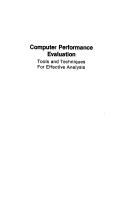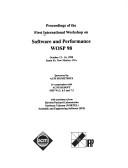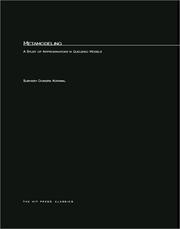| Listing 1 - 10 of 173 | << page >> |
Sort by
|

ISBN: 0442803257 9780442803254 Year: 1982 Publisher: New York Van Nostrand Reinhold
Abstract | Keywords | Export | Availability | Bookmark
 Loading...
Loading...Choose an application
- Reference Manager
- EndNote
- RefWorks (Direct export to RefWorks)

ISBN: 1581130600 9781581130607 Year: 1998 Publisher: ACM
Abstract | Keywords | Export | Availability | Bookmark
 Loading...
Loading...Choose an application
- Reference Manager
- EndNote
- RefWorks (Direct export to RefWorks)

ISBN: 0262010801 9780262255561 9780262511445 0262255561 9780262010801 Year: 1984 Publisher: Cambridge, Massachusetts [Piscataqay, New Jersey] MIT Press IEEE Xplore
Abstract | Keywords | Export | Availability | Bookmark
 Loading...
Loading...Choose an application
- Reference Manager
- EndNote
- RefWorks (Direct export to RefWorks)
Digital computer simulation --- Electronic digital computers --- Queuing theory --- Approximation theory --- Evaluation --- Approximation theory. --- Digital computer simulation. --- Queuing theory. --- Evaluation. --- Electronic digital computers - Evaluation
Periodical
ISSN: 01635999
Abstract | Keywords | Export | Availability | Bookmark
 Loading...
Loading...Choose an application
- Reference Manager
- EndNote
- RefWorks (Direct export to RefWorks)
Computer software --- Electronic digital computers --- Logiciels --- Ordinateurs --- Evaluation --- Periodicals --- Périodiques --- #ETEW:TSCAT --- #BA01105 --- Computers --- Information Technology --- Mathematical Sciences --- General and Others --- Applied Mathematics --- Computer. Automation --- Évaluation --- Electronic digital computers - Evaluation - Periodicals --- Computer software - Evaluation - Periodicals --- Ordinateurs - Évaluation - Périodiques
Multi
ISBN: 9783031221552 9783031221545 9783031221569 Year: 2023 Publisher: Cham Springer International Publishing
Abstract | Keywords | Export | Availability | Bookmark
 Loading...
Loading...Choose an application
- Reference Manager
- EndNote
- RefWorks (Direct export to RefWorks)
This graduate-level textbook is ideally suited for lecturing the most relevant topics of Edge Computing and its ties to Artificial Intelligence (AI) and Machine Learning (ML) approaches. It starts from basics and gradually advances, step-by-step, to ways AI/ML concepts can help or benefit from Edge Computing platforms. The book is structured into seven chapters; each comes with its own dedicated set of teaching materials (practical skills, demonstration videos, questions, lab assignments, etc.). Chapter 1 opens the book and comprehensively introduces the concept of distributed computing continuum systems that led to the creation of Edge Computing. Chapter 2 motivates the use of container technologies and how they are used to implement programmable edge computing platforms. Chapter 3 introduces ways to employ AI/ML approaches to optimize service lifecycles at the edge. Chapter 4 goes deeper in the use of AI/ML and introduces ways to optimize spreading computational tasks along edge computing platforms. Chapter 5 introduces AI/ML pipelines to efficiently process generated data on the edge. Chapter 6 introduces ways to implement AI/ML systems on the edge and ways to deal with their training and inferencing procedures considering the limited resources available at the edge-nodes. Chapter 7 motivates the creation of a new orchestrator independent object model to descriptive objects (nodes, applications, etc.) and requirements (SLAs) for underlying edge platforms. To provide hands-on experience to students and step-by-step improve their technical capabilities, seven sets of Tutorials-and-Labs (TaLs) are also designed. Codes and Instructions for each TaL is provided on the book website, and accompanied by videos to facilitate their learning process.
Programming --- Computer architecture. Operating systems --- Computer. Automation --- informatica --- computerbesturingssystemen --- programmeren (informatica) --- software engineering --- computernetwerken --- Computer networks. --- Software engineering. --- Machine learning. --- Electronic digital computers—Evaluation. --- Computer Communication Networks. --- Software Engineering. --- Machine Learning. --- System Performance and Evaluation.
Book
ISBN: 1280618191 9786610618194 3540302921 Year: 2006 Publisher: Berlin ; New York : Springer,
Abstract | Keywords | Export | Availability | Bookmark
 Loading...
Loading...Choose an application
- Reference Manager
- EndNote
- RefWorks (Direct export to RefWorks)
Das 19. Fachgespräch Autonome Mobile Systeme (AMS 2005) ist ein Forum, das Wissenschaftlerinnen und Wissenschaftlern aus Forschung und Industrie, die auf dem Gebiet der autonomen mobilen Systeme arbeiten, eine Basis für den Gedakenaustausch bietet und wissenschfltiche Diskussionen sowie Kooperationen auf diesem Forschungsgebiet fördert bzw. initiiert. Ausgewählte Beiträge zu den Themen Kooperative Systeme, Bildverarbeitung, Lokalisierung und Kartographierung, Outdoor-Systeme, Fahrerassistenzsysteme, Kognitive Sensordatenverarbeitung, Architekturen und Anwendungen sowie Steuerung und Navigation bilden den Inhalt dieses Bandes.
Control engineering. --- Artificial intelligence. --- Computer systems. --- Application software. --- Microprocessors. --- Computer architecture. --- Electronic digital computers—Evaluation. --- Control and Systems Theory. --- Artificial Intelligence. --- Computer System Implementation. --- Computer and Information Systems Applications. --- Processor Architectures. --- System Performance and Evaluation. --- Mobile robots --- Robots
Book
Year: 2005 Publisher: Berlin ; New York : Springer,
Abstract | Keywords | Export | Availability | Bookmark
 Loading...
Loading...Choose an application
- Reference Manager
- EndNote
- RefWorks (Direct export to RefWorks)
Welcome to the proceedings of ISPA 2005 which was held in the city of Nanjing. Parallel computing has become a mainstream research area in computer science and the ISPA conference has become one of the premier forums for the presentation of new and exciting research on all aspects of parallel computing. We are pleased to present the proceedings for the 3rd International Symposium on Parallel and Distributed Processing and Applications (ISPA 2005), which comprises a collection of excellent technical papers, and keynote speeches. The papers accepted cover a wide range of exciting topics, including architectures, software, networking, and applications. The conference continues to grow and this year a record total of 968 manuscripts (including workshop submissions) were submitted for consideration by the Program Committee or workshops. From the 645 papers submitted to the main conference, the Program Committee selected only 90 long papers and 19 short papers in the program. Eight workshops complemented the outstanding paper sessions.
Computer systems. --- Algorithms. --- Computer networks. --- Application software. --- Electronic digital computers—Evaluation. --- Software engineering. --- Computer System Implementation. --- Computer Communication Networks. --- Computer and Information Systems Applications. --- System Performance and Evaluation. --- Software Engineering. --- Parallel processing (Electronic computers) --- Electronic data processing --- Distributed processing
Book
ISBN: 1282826034 9786612826030 3642102840 Year: 2009 Publisher: Berlin ; Heidelberg : Springer-Verlag,
Abstract | Keywords | Export | Availability | Bookmark
 Loading...
Loading...Choose an application
- Reference Manager
- EndNote
- RefWorks (Direct export to RefWorks)
Das 21. Fachgespräch Autonome Mobile Systeme (AMS 2009) ist ein Forum, das Wissenschaftlerinnen und Wissenschaftlern aus Forschung und Industrie, die auf dem Gebiet der autonomen mobilen Systeme arbeiten, eine Basis für den Gedankenaustausch bietet und wissenschaftliche Diskussionen sowie Kooperationen auf diesem Forschungsgebiet fördert bzw. initiiert. Inhaltlich finden sich ausgewählte Beiträge zu den Themen Humanoide Roboter und Flugmaschinen, Perzeption und Sensorik, Kartierung und Lokalisation, Regelung, Navigation, Lernverfahren, Systemarchitekturen sowie der Anwendung von autonomen mobilen Systemen.
Artificial intelligence. --- Application software. --- Computer systems. --- Microprocessors. --- Computer architecture. --- Electronic digital computers—Evaluation. --- Artificial Intelligence. --- Computer and Information Systems Applications. --- Computer System Implementation. --- Processor Architectures. --- System Performance and Evaluation. --- Mobile robots --- Robots
Book
Abstract | Keywords | Export | Availability | Bookmark
 Loading...
Loading...Choose an application
- Reference Manager
- EndNote
- RefWorks (Direct export to RefWorks)
Welcome to the post proceedings of the First International Conference on Embedded Software and Systems (ICESS 2004), which was held in Hangzhou, P. R. China, 9–10 December 2004. Embedded Software and Systems technology is of increasing importance for a wide range of industrial areas, such as aerospace, automotive, telecommunication, and manufacturing automation. Embedded technology is playing an increasingly dominant role in modern society. This is a natural outcome of amazingly fast developments in the embedded field. The ICESS 2004 conference brought together researchers and developers from academia, industry, and government to advance the science, engineering, and technology in embedded software and systems development, and provided them with a forum to present and exchange their ideas, results, work in progress, and experience in all areas of embedded systems research and development. The ICESS 2004 conference attracted much more interest than expected. The total number of paper submissions to the main conference and its three workshops, namely, Pervasive Computing, Automobile Electronics and Tele-communication, was almost 400, from nearly 20 countries and regions. All submissions were reviewed by at least three Program or Technical Committee members or external reviewers. It was extremely difficult to make the final decision on paper acceptance because there were so many excellent, foreseeing, and interesting submissions with brilliant ideas.
Software engineering. --- Computer networks. --- Microprocessors. --- Computer architecture. --- Computers, Special purpose. --- Electronic digital computers—Evaluation. --- Software Engineering. --- Computer Communication Networks. --- Processor Architectures. --- Special Purpose and Application-Based Systems. --- System Performance and Evaluation. --- Embedded computer systems
Book
Year: 2005 Publisher: Berlin ; New York : Springer,
Abstract | Keywords | Export | Availability | Bookmark
 Loading...
Loading...Choose an application
- Reference Manager
- EndNote
- RefWorks (Direct export to RefWorks)
Computer systems. --- Algorithms. --- Computer networks. --- Application software. --- Electronic digital computers—Evaluation. --- Software engineering. --- Computer System Implementation. --- Computer Communication Networks. --- Computer and Information Systems Applications. --- System Performance and Evaluation. --- Software Engineering. --- Parallel processing (Electronic computers) --- Electronic data processing --- Distributed processing
| Listing 1 - 10 of 173 | << page >> |
Sort by
|

 Search
Search Feedback
Feedback About UniCat
About UniCat  Help
Help News
News